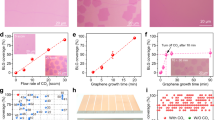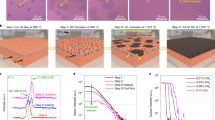Abstract
Bernal (AB)-stacked bilayer graphene (BLG) is a semiconductor whose bandgap can be tuned by a transverse electric field, making it a unique material for a number of electronic and photonic devices1,2,3. A scalable approach to synthesize high-quality BLG is therefore critical, which requires minimal crystalline defects in both graphene layers4,5 and maximal area of Bernal stacking, which is necessary for bandgap tunability6. Here we demonstrate that in an oxygen-activated chemical vapour deposition (CVD) process, half-millimetre size, Bernal-stacked BLG single crystals can be synthesized on Cu. Besides the traditional ‘surface-limited’ growth mechanism for SLG (1st layer), we discovered new microscopic steps governing the growth of the 2nd graphene layer below the 1st layer as the diffusion of carbon atoms through the Cu bulk after complete dehydrogenation of hydrocarbon molecules on the Cu surface, which does not occur in the absence of oxygen. Moreover, we found that the efficient diffusion of the carbon atoms present at the interface between Cu and the 1st graphene layer further facilitates growth of large domains of the 2nd layer. The CVD BLG has superior electrical quality, with a device on/off ratio greater than 104, and a tunable bandgap up to ∼100 meV at a displacement field of 0.9 V nm−1.
This is a preview of subscription content, access via your institution
Access options
Subscribe to this journal
Receive 12 print issues and online access
$259.00 per year
only $21.58 per issue
Buy this article
- Purchase on Springer Link
- Instant access to full article PDF
Prices may be subject to local taxes which are calculated during checkout




Similar content being viewed by others
Change history
26 February 2016
In the version of this Letter originally published online, in Fig. 2d, the values on the y axis were incorrect. This error has been corrected in all versions of the Letter.
References
Geim, A. K. & Novoselov, K. S. The rise of graphene. Nature Mater. 6, 183–191 (2007).
Zhang, Y. et al. Direct observation of a widely tunable bandgap in bilayer graphene. Nature 459, 820–823 (2009).
Yan, J. et al. Dual-gated bilayer graphene hot-electron bolometer. Nature Nanotechnol. 7, 472–478 (2012).
Yu, Q. et al. Control and characterization of individual grains and grain boundaries in graphene grown by chemical vapour deposition. Nature Mater. 10, 443–449 (2011).
Yazyev, O. V. & Louie, S. G. Electronic transport in polycrystalline graphene. Nature Mater. 9, 806–809 (2010).
Kim, K. et al. Raman spectroscopy study of rotated double-layer graphene: misorientation angle dependence of electronic structure. Phys. Rev. Lett. 108, 246103 (2012).
Batzill, M. The surface science of graphene: metal interfaces, CVD synthesis, nanoribbons, chemical modifications, and defects. Surf. Sci. Rep. 67, 83–115 (2012).
Kim, K. S. et al. Large-scale pattern growth of graphene films for stretchable transparent electrodes. Nature 457, 706–710 (2010).
Weatherup, R. S. et al. Interdependency of subsurface carbon distribution and graphene-catalyst interactions. J. Am. Chem. Soc. 136, 13698–13708 (2014).
Mattevi, C., Kim, H. & Chhowalla, M. A review of chemical vapour deposition of graphene on copper. J. Mater. Chem. 21, 3324–3334 (2011).
Lee, S., Lee, K. & Zhong, Z. Wafer scale homogeneous bilayer graphene films by chemical vapor deposition. Nano Lett. 10, 4702–4707 (2010).
Liu, W. et al. Controllable and rapid synthesis of high-quality and large-area Bernal stacked bilayer graphene using chemical vapor deposition. Chem. Mater. 26, 907–915 (2014).
Zhou, H. et al. Chemical vapor deposition growth of large single crystals of monolayer and bilayer graphene. Nature Commun. 4, 2096 (2013).
Yan, K., Peng, H., Zhou, Y., Li, H. & Liu, Z. Formation of bilayer Bernal graphene: layer-by-layer epitaxy via chemical vapor deposition. Nano Lett. 11, 1106–1110 (2011).
Fang, W. et al. Asymmetric growth of bilayer graphene on copper enclosures using low pressure chemical vapor deposition. ACS Nano 8, 6491–6499 (2014).
Sun, Z. et al. Large-area Bernal-stacked bi-, tri-, and tetralayer graphene. ACS Nano 6, 9790–9796 (2012).
Liu, L. et al. High-yield chemical vapor deposition growth of high-quality large-area AB-stacked bilayer graphene. ACS Nano 6, 8241–8249 (2012).
Zhao, P. et al. Equilibrium chemical vapor deposition growth of Bernal-stacked bilayer graphene. ACS Nano, 8, 11631–11638 (2014).
Hao, Y. et al. The role of surface oxygen in the growth of large single-crystal graphene on copper. Science 342, 720–723 (2013).
Hao, Y. et al. Probing layer number and stacking order of few-layer graphene by Raman spectroscopy. Small 6, 195–200 (2010).
Vlassiouk, I. et al. Graphene nucleation density on copper: fundamental role of background pressure. J. Phys. Chem. C 117, 18919–18926 (2013).
Yan, Z. et al. Toward the synthesis of wafer-scale single-crystal graphene on copper foils. ACS Nano 6, 9110–9117 (2012).
Li, X., Cai, W., Colombo, L. & Ruoff, R. S. Evolution of graphene growth on Ni and Cu by carbon isotope labeling. Nano Lett. 9, 4268–4272 (2009).
Kim, H. et al. Activation energy paths for graphene nucleation and growth on Cu. ACS Nano, 6, 3614–3623 (2012).
López, G. A. & Mittemeijer, E. J. The solubility of C in solid Cu. Scr. Mater. 51, 1–5 (2004).
Kidambi, P. R. et al. Observing graphene grow: catalyst-graphene interactions during scalable graphene growth on polycrystalline copper. Nano Lett. 13, 4769–4778 (2013).
Riikonen, S., Krasheninnikov, A. V., Halonen, L. & Nieminen, R. M. The role of stable and mobile carbon adspecies in copper-promoted graphene growth. J. Phys. Chem. C 116, 5802–5809 (2012).
Zhang, W., Wu, P., Li, Z. & Yang, J. First-principles thermodynamics of graphene growth on Cu surfaces. J. Phys. Chem. C, 115, 17782–17787 (2011).
Taychatanapat, T. & Jarillo-Herrero, P. Electronic transport in dual-gated bilayer graphene at large displacement fields. Phys. Rev. Lett. 105, 166601 (2010).
Fang, W. et al. Rapid identification of stacking orientation in isotopically labeled chemical-vapor grown bilayer graphene by Raman spectroscopy. Nano Lett. 13, 1541–1548 (2013).
Acknowledgements
We thank J. B. Goodenough, Z. Zhang, N. C. Bartelt, F. Wang, D. Su, E. Stach, G. A. López, E. J. Mittemeijer, L. Ju, and J. Yin for valuable discussions and/or technical assistance. We thank K. Watanabe and T. Taniguchi for providing h-BN crystals. Work at Columbia University was supported by Office of Naval Research (ONR) -N000141310662 and the Nanoelectronics Research Initiative (NRI) through the Institute for Nanoelectronics Discovery and Exploration (INDEX). Work at Austin was supported by the NRI through the South West Academy of Nanoelectronics (SWAN). Work at Sandia was supported by the Office of Basic Energy Sciences, Division of Materials and Engineering Sciences, US Department of Energy (DOE) under Contract No. DE-AC04-94AL85000. Work at Rice University was supported by the ONR and NSF's Chemical, Bioengineering, Environmental, and Transport Systems Division. Work at NREL was supported by DOE under Contract No. DE-AC36-08GO28308, and used the NREL Peregrine Supercomputer and NERSC clusters (supported by DOE DE-AC02-05CH11231). Work at Hong Kong was supported by Hong Kong University of Science and Technology under award RPC11EG39. Work at Harvard University was supported by the Air Force Office of Scientific Research under contract no. FA9550-13-1-0211. Work at Sungkyunkwan University was supported by the convergence technology development program for bionic arm (no. 2014M3C1B2048175) and the Basic Science Research Program (NRF-2014R1A1A1004818) through the National Research Foundation of Korea (NRF) funded by the Ministry of Science, ICT & Future Planning. H. C. was supported by NSF DMR-1122603 and by ONR-N00014-14-1-0330. C. T. was supported by a National Defense Science and Engineering Graduate (NDSEG) Fellowship - FA9550-11-C-0028. R.S.R. was supported by IBS-R019-D1.
Author information
Authors and Affiliations
Contributions
Y.F.H., R.S.R., and L.C. conceived the experiments. Y.F.H. designed and performed all the growth experiments and graphene transfer. R.S.R., J.H. and L.C. supervised the project. Y.F.H., H.C., L.C., J.H., K.F.M., X.W., C.T., J.W.S., and R.S.R. analysed experimental results and the data. L.W., Y.F.H., J.H., P.K., and C.R.D. performed electrical measurements. Y.L. and B.I.Y. performed DFT calculations. K.F.M. and S.N. performed LEEM and LEED experiments. T. J. performed the focus ion beam cutting. T.L., J.X., and W.Y. performed the gas exchange rate calculations. Y.F.H., H.C., J.H., R.S.R., and L.C. wrote the manuscript. All co-authors revised and commented on the manuscript.
Corresponding authors
Ethics declarations
Competing interests
The authors declare no competing financial interests.
Supplementary information
Supplementary information
Supplementary information (PDF 7658 kb)
Rights and permissions
About this article
Cite this article
Hao, Y., Wang, L., Liu, Y. et al. Oxygen-activated growth and bandgap tunability of large single-crystal bilayer graphene. Nature Nanotech 11, 426–431 (2016). https://doi.org/10.1038/nnano.2015.322
Received:
Accepted:
Published:
Issue Date:
DOI: https://doi.org/10.1038/nnano.2015.322
This article is cited by
-
Theoretical investigations on the growth of graphene by oxygen-assisted chemical vapor deposition
Nano Research (2024)
-
Towards growth of pure AB-stacked bilayer graphene single crystals
Nano Research (2024)
-
Enhanced copper anticorrosion from Janus-doped bilayer graphene
Nature Communications (2023)
-
Growth of single-crystal black phosphorus and its alloy films through sustained feedstock release
Nature Materials (2023)
-
Invisible vapor catalysis in graphene growth by chemical vapor deposition
Nano Research (2023)



